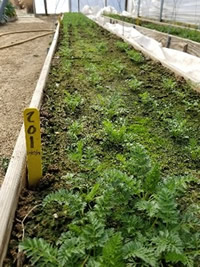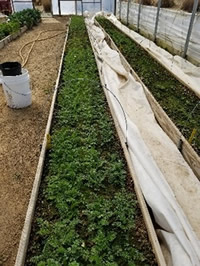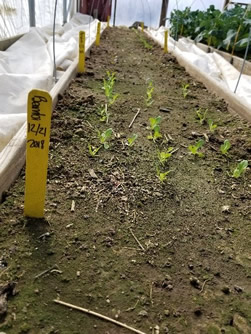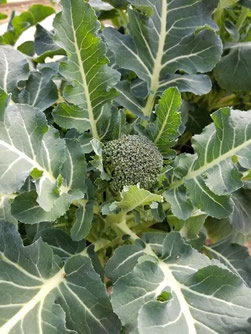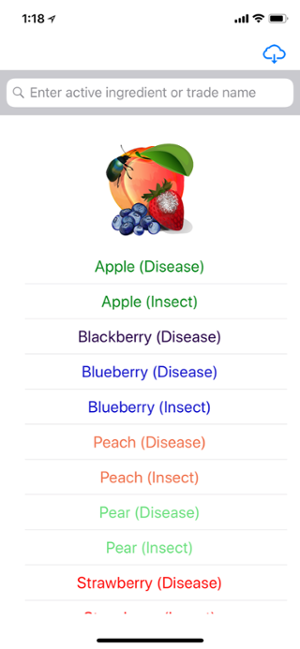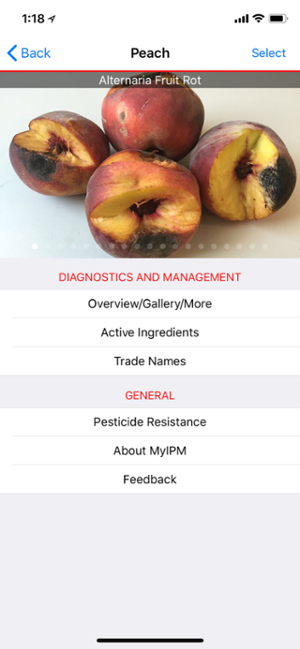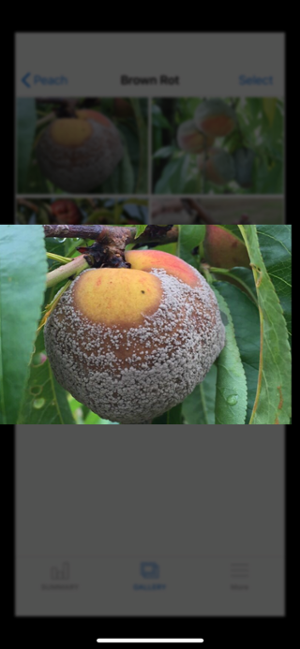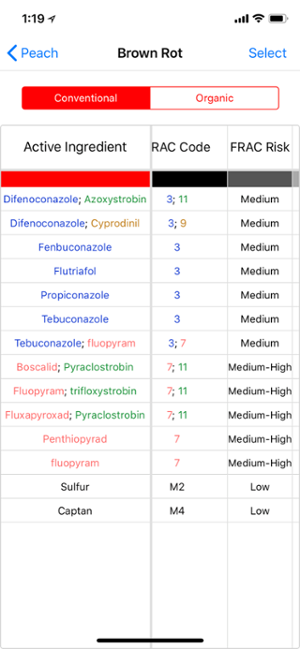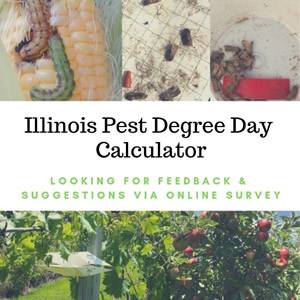Address any questions or comments regarding this newsletter to the individual authors listed after each article or to its editors, Nathan Johanning, 618-939-3434, njohann@illinois.edu or Bronwyn Aly 618-695-6060, baly@illinois.edu. The Illinois Fruit and Vegetable News is available on the web at: http://ipm.illinois.edu/ifvn/. To receive or be removed from email notification of new postings of this newsletter, contact Nathan Johanning or Bronwyn Aly at the phone numbers or email addresses above.
In This Issue:
Upcoming Programs ((listings for beginning and established growers))
News & Announcements ((Birth Announcement x 2))
Regional Reports ((St. Louis metro east, west central Illinois (x2), southern Illinois, Dixon Springs))
Fruit and Vegetable Pest Management ((Disease Fact Sheets, MyIPM Smartphone App Series, Feedback Sought on Pest Degree Day Calculator Upgrade))
Upcoming Programs
Check the Illinois SARE calendar for a full list of programs and links for registration. http://illinoissare.org/ and http://illinoissare.org/calendar.php Also see the University of Illinois Extension Local Food Systems and Small Farms Team’s website at: http://web.extension.illinois.edu/smallfarm/ and the calendar of events at http://web.extension.illinois.edu/units/calendar.cfm?UnitID=629.
-
2019 Small Farms Winter Webinar Series, Thursdays at noon, from January 24 –April 4, 2019.
Registration is open for the 2019 series with a whole new set of topics! It’s easy (and FREE!) to register for the Small Farms Winter Webinars. Sign up for as many as you want at https://go.aces.illinois.edu/SmallFarmWinterWebinar. We’ll send you a webinar reminder, log-on instructions, and how to access the archived recording. If you do not have broadband internet capable of streaming video, call your local Extension office to see if they can offer live viewing.
Topics for this year’s series are:
Feb. 21 FSMA Produce Safety Exemptions and Guidance: What You Need to Know for 2019
- Zack Grant, University of Illinois Extension Local Food Systems and Small Farms Educator Feb. 28 Maximizing Your Production: Succession and Companion Planting
- Laurie George, University of Illinois Extension Local Food Systems and Small Farms Educator Mar. 7 Healthy Soil Produces Healthy Vegetables
- James Theuri, University of Illinois Extension Local Food Systems and Small Farms Educator Mar. 14 The Best Practices for Maintaining Healthy Bee Hives
- Doug Gucker, University of Illinois Extension Local Food Systems and Small Farms Educator Mar. 21 Reducing Damage to Livestock and Specialty Crops from Wildlife
- Dave Shiley, University of Illinois Extension Local Food Systems and Small Farms Educator Mar. 28 Agroforestry for Diversification on Small Scale Farms
- Bill Davison, University of Illinois Extension Local Food Systems and Small Farms Educator Apr. 4 ABCs of Tomato Production
- Bronwyn Aly, University of Illinois Extension Local Food Systems and Small Farms Educator - Severe Storm Seminar, Saturday, March 16, 2019, Jackson County Extension Office, 402 Ava Road, Murphysboro, IL 62966. Extension educator and weather instructor Duane Friend will talk about types of thunderstorms, how lightning forms, tornadoes and current research, and will touch on how weather extremes are predicted to change over time. He will also answer any questions participants have on weather related issues. Registration is online: https://go.illinois.edu/severeweather2019. Please call Maggie Ray at 618-687-1727 for more information.
News & Announcements
Birth Announcement x 2
Congratulations to Nathan and Heather Johanning on the birth of their beautiful girls, Lilah Cay and Jessa Rose! Babies arrived healthy and happy on February 9, 2019. Big brother Ethan will be great help in taking care of his new little sisters. Nathan is currently off on parental leave but will be back in the office on April 8, 2019.
Regional Reports
From St Louis Metro East...The Southern Illinois Fruit and Vegetable School came to a successful conclusion Friday, February 8th in Mt Vernon, IL. For those unable to attend, color copies of the presentations from the vegetable, small fruit and tree fruit sessions are available online at https://go.illinois.edu/2019SIFVS.
In addition, you may have noticed Illinois Specialty Growers Association has launched a new website https://www.specialtygrowers.org/. Presentations from the 2019 Illinois Specialty Growers, Agritourism and Organic Conference are now available under the “Educate” tab.
The St Louis Metro East has been very wet, with roller coaster soil thawing and freezing. From the beginning of the year, the SIU Belleville Research Station has recorded 6.5” of rain and 13.7” of snow. As of Feb 19th, soil temperature at 4” (bare soil) was at 30.4. Soil temperature 4” below sod was at 33.9⁰ F. Few signs of spring are present. Even plants that are notoriously early bloomers and harbingers of spring, like witch hazel and Cornelian cherry dogwood, are behind in development compared to previous years. This can all turn around in a hurry, but for now everything is stalled somewhat until a bit of warmth comes our way.
Elizabeth Wahle (618-344-4230; wahle@illinois.edu)
From west central Illinois...As we prepare for yet another round of winter weather, spring is certainly on the minds of everyone. Growers have begun starting seed indoors. About two weeks ago onions were being seeded in flats. Now begins the indoor seeding of cool season crops of greens to transplant once the soils are thawed and can be worked. Several growers are going through their low tunnel materials, checking to make sure everything is ready and ordering supplies when necessary. Those with heated greenhouses or high tunnels may also be getting a start on their warm season crops.
Based on the conversations I was hearing in a roomful of growers last week, there is going to be a lot of high tunnel repair this spring. Several growers remarked the winter has been very hard on their tunnels.
In my low tunnel, the spinach has held very well. Meanwhile, I’m not so sure about the carrots on the other end of the tunnel. Last week, freezing rain and high winds collapsed one end of the low tunnel, smashing the carrots underneath and then about an inch of ice formed on the flattened plastic. I hope that the carrots will remain protected enough until this weekend when warmer temperatures should thaw out the skating rink on top of my garden beds.
I brought in my bag of potting soil to thaw it out as I begin pre-sprouting my ginger rhizomes. This year I plan to plant most of these in fabric pots inside the high tunnel and relocate them outside during the heat of summer. Last year I tried mostly in vain to keep the soil temperatures in my tunnel under 90 degrees Fahrenheit. Though ginger is a tropical plant, soil temperatures over 90 is stressful to the plant. To manage the temperatures I used constant ventilation, running drip and misters on timers, and shade. Pretty much everything short of taking the high tunnel down. One method of ginger production I would like to explore is the use of caterpillar tunnels. I would employ poly plastic on the caterpillar tunnel and row cover inside in the spring and fall. During the hot days of summer removal of the plastic and installation of shade cloth to manage temperatures. As the year goes on, I’ll keep you updated on the trials and tribulations of growing ginger.
Chris Enroth (309-837-3939; cenroth@illinois.edu)
From west central Illinois… This has been an extraordinary winter, at least compared to those of recent memory. Our area received a major snow fall the weekend of Jan. 12-13. We measured 13” at our place. It came over 24 hours, with little wind. Hence it settled onto our high tunnels, anywhere from 2-12” deep. Several times during that weekend I felt the need to remove as much as possible to reduce any concern of snow load. I found the best method of removal consisted of utilizing a push broom, and pushing from the inside to loosen the snow and allow most to slide off. I had originally tried attaching the broom to a rope on each side of the tunnel and alternatively pulling from one side to the other, but the snow accumulation alongside the tunnel was too deep, almost 5’. We have two tunnels, one gothic and one Quonset. There did appear to be less snow accumulated on the gothic tunnel.
The length of this winter concerns me somewhat due to the fact that come spring, things are going to get extremely hectic. My major concern is of timely fertilization and field work. Across the northern 2/3 of Illinois, in most falls, upwards of 50-60% of nitrogen is applied for the upcoming corn crop. This year, perhaps 10% may have gotten applied. Every commercial fertilizer operation (and corn farmer) is hoping for an early spring to help reduce the load they will be expecting. The problem will be exasperated due to the inability to keep supplies of product on hand. There are only so many anhydrous tankers available. And everyone will need to resupply, thus a major bottleneck. Producers will most likely try alternative sources, such as urea or UAN, but those will be in short supply as well since producers will most likely try and switch. And very few sidedress applicators are around, thus requiring pre plant nitrogen application. The reason for this concern is that if you rely upon commercial fertilizer dealers for your plant nutrition needs, they will be extremely busy. It might be a good time to consult with them regarding the how’s and when’s for your operation, before the spring rush.
The other concern with timeliness is the extreme wet condition of the soil, although that can change easily. But tile lines have been running for several months, indicating a rather saturated soil profile. And we keep getting moisture. There are ruts in some fields due to excessive soil moisture last fall during harvest, which will need to be filled in. At this point in time, it’s looking like a very late spring. But you never know, things can turn around quickly, and most folks are certainly hoping they will.
The near record cold on Jan. 30 saw our low reach negative 13. I was very concerned for the head lettuce we have growing in our tunnels. The lettuce is almost fully mature, which usually implies a less capacity to tolerate colder temperatures. I have a row cover that I placed over the lettuce, 3 layers thick of 1 ounce fabric. Several days after the cold, I removed the covers to discover that the lettuce had survived. There were some leaf margins that were singed, but overall I was very impressed with the survival, much better than I had hoped. I’ve used a row cover to help protect the lettuce quite a few times this winter, but usually only one layer thick. And prior to the extreme cold, we had 7-10 days with very little sun to get some heat stored in the soil of the tunnel to buffer against the cold.
We also have spinach growing in our tunnels, and the last picking of that was around 2 months ago. We expect no growth to occur, due to limited sunlight and temperatures, from mid-December to about the end of January. But this year, due to cloudy conditions, the limited growth has been a little longer. I’m hoping to pick again the end of February, as day length has extended (if the sun would ever show itself) to almost 11 hours already.
We had a good layer of snow to help insulate our plasticulture strawberry plants for most of January, but the last week or so of that month saw rain instead of snow, which prompted the snow to pretty much disappear. Then the negative 13 degree temperature of Jan. 30 really had me worried about desiccation of leaves under the row cover. I pulled up a corner on Feb. 14 to look, and wasn’t surprised when I estimated about 60-70% desiccation on the plant. We’ve had this amount before and I don’t think the yield suffered too much then, hoping for similar this year.
Most growers have placed seed orders and seed is arriving. High tunnel tomato growers in our area are starting seed (or already have if they heat their tunnel) for transplanting. It takes about 5-6 weeks under good growing conditions for tomato seed to reach transplant stage. And most growers in this area, with unheated tunnels, try and get them in the ground around April 1. Soon they will start pepper seed. Apples are being pruned as are grapes, although it’s been difficult with the weather. We’ve had snow cover and then quite a bit of ice lately, which makes for dangerous conditions for equipment in the orchard.

Strawberry plasticulture plant dessication from mid-February in Quincy, IL following polar vortex event the last of January. Photo by Mike Roegge
Mike Roegge (roegge@adams.net )
From southern Illinois… All of our high tunnel crops survived the polar vortex! We experienced lows well into the single digits with wind-chills into the negatives in Murphysboro. I was worried about our broccoli crop that has been slowly growing since transplanted in October. Everything survived and you can see in the picture that our broccoli is starting to form some beautiful crowns. The high tunnel is an amazing and cost efficient way to grow all year round. When utilizing the low tunnel system inside the high tunnels, we are able to store more heat in the soil than you would just having only the high tunnel as protection. We have a thermometer in one of our carrot beds and the lowest I’ve seen the soil temperature drop is to around 40-45 degrees F.
You can see in the thermometer picture that the temp is just above 60 degrees F. On this day it was very sunny (2/13/19) with a high of about 53 degrees F outside and inside the tunnel, it was approaching 80 degrees F. The high tunnel was half way open and all the beds were uncovered. Being able to uncover the beds on these sunny days is crucial to letting the soil absorb more heat throughout the day as well as moderate extreme temperature fluctuations that can be stressful to the plants.
We have harvested arugula, spinach, and lettuce a few times. On December 21 we started some seeds by covering the beds with clear plastic. It took a little longer time than it normally would in a greenhouse but it was surprisingly faster than expected. All these seedlings are growing in nicely, we planted two different types of kale (purple & green), a purple and green mini bib lettuce, collard greens, Swiss chard, and some more leaf lettuce.
Our carrot project observing seeding times is going well. You can see two different beds pictured, plot 301 seeded on 10/8 and the other, plot 201 seeded on 10/29. The early seeded carrots have a lot more vigor and have a visibly higher germination rate than the ones planted almost 20 days later.
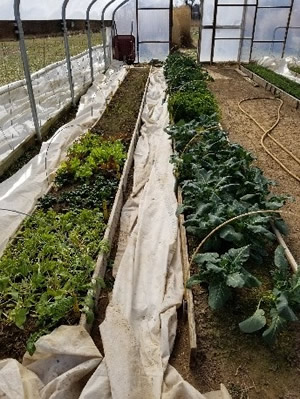
Photo 1. Left bed contains arugula, spinach, lettuce, and new seedlings. Right bed contains October planted broccoli.
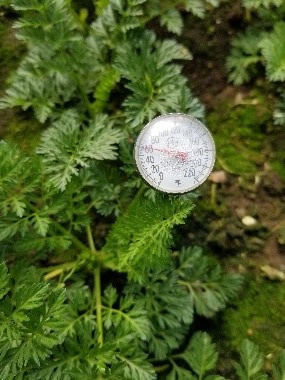
Photo 2. Soil thermometer showing temperature just above 60 F.

